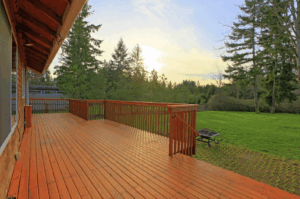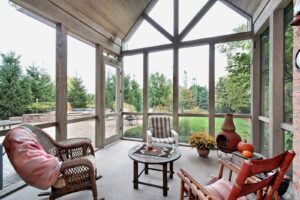What if you could step into your backyard and find a tranquil oasis that feels like an extension of your home where you can relax, entertain, and enjoy nature?
This is possible through the art of hardscaping.
But what is hardscaping, exactly?
Unlike traditional landscaping, which involves planting and greenery, hardscaping focuses on the non-living elements of your outdoor space.
Think of patios, walkways, stone walls, and pergolas, all essential features that define and enhance your yard’s structure.
Hardscaping also adds aesthetic value, giving your yard a polished and cohesive look.
Moreover, it can increase your property’s value and appeal while reducing maintenance efforts! 💵
Understanding Hardscaping
To adequately answer the question of “what is hardscaping?” it’s essential to differentiate it from landscaping, as both play pivotal roles in backyard transformation.
Hardscaping serves as the backbone of any landscape design, offering a framework that supports and enhances the organic features of your garden or yard.
It includes everything from pathways and patios to retaining walls and fences, creating a cohesive and structured environment.
Materials Matter
Common materials used in hardscaping include stone, concrete, and wood, each bringing its unique charm and utility to a backyard setting.
Stone offers a natural and timeless appearance, making it ideal for creating rustic patios or elegant garden paths.
Concrete, known for its durability and versatility, can be molded into various shapes and patterns, making it a popular choice for modern designs.
Wood adds warmth and texture, perfect for constructing decks or pergolas that blend seamlessly with the surrounding greenery.
Selecting the right material can significantly impact your outdoor space’s overall look and feel.
Hardscaping Within a Budget is Entirely Possible
Setting a realistic budget is crucial to avoid unexpected financial strain during your project.
Begin by researching the cost of hardscaping materials and labor in your area, keeping in mind that prices can vary significantly based on quality and availability.
It’s wise to allocate funds not just for materials and construction but also for potential surprises, like addressing drainage problems or upgrading soil conditions.
With a well-defined budget, you can confidently make decisions that align with your financial capabilities while achieving your dream outdoor space.
Let Us Help with Your Outdoor Living Project
A Deck Above is the area’s premier builder of decks and a wide variety of structures to maximize your enjoyment of outdoor living.
Common Features
Among the many features that define hardscaping, patios, walkways, and retaining walls stand out for their practicality and visual appeal.
A well-designed patio extends your indoor living area, providing a perfect spot for entertaining guests or enjoying a quiet evening under the stars.
Walkways guide visitors through your garden, offering a safe and inviting path while preventing wear on grassy areas.
Retaining walls add dimension and depth to sloped landscapes and help manage soil erosion and water drainage effectively.
What is Hardscaping if not Functional?
Embarking on a hardscaping project begins with clearly understanding your backyard space and needs.
Start by observing how you currently use your outdoor area and identify any limitations or enhancements you desire.
Do you need a safe play area for children, a cozy nook for reading, or an inviting space for entertaining guests?
These considerations will guide your hardscape design ideas.
Sketch out a simple plan, marking existing features like trees and slopes, which can influence the placement of new elements such as patios or walkways.
Remember, the goal is to create a harmonious flow between the hardscape and the natural environment.
Don’t Be Afraid to Combine Features
Creating a functional and aesthetic design plan involves balancing practicality with visual appeal.
Take inspiration from various hardscape design ideas that align with your personal style, whether it’s sleek modern lines or rustic charm.
Also, consider how your design will look throughout the seasons; for instance, using permeable pavers can help manage water runoff in rainy months while adding texture and interest year-round.
Visualization tools, like 3D modeling software, can be invaluable in bringing your vision to life and identifying potential issues before breaking ground.
DIY vs. Professional Help
Embarking on a hardscaping project, such as a patio installation or creating intricate garden paths, can be rewarding for any DIY enthusiast.
Taking the DIY route offers several advantages: it allows you to work at your own pace, customize the design to your liking, and potentially save on labor costs.
However, it also requires a good deal of time, patience, and skill.
Without the right tools or experience, you may face challenges that compromise the quality and safety of your project.
Moreover, the project’s scope often dictates whether it’s feasible for a DIY approach; smaller projects like simple stone pathways may be more manageable than complex retaining walls.
Maintenance and Longevity
Regular maintenance is key to ensuring the longevity of your hardscape features.
Routine tasks like sweeping patios and walkways to remove dirt and debris will prevent surface wear and staining.
It’s also essential to periodically check for loose stones or pavers and re-secure them to avoid potential hazards.
Applying a sealant every couple of years for wooden elements such as decks or pergolas can protect against moisture and UV damage, keeping them fresh and sturdy.
What is Hardscaping if not an Exciting Journey?
Now that you’ve got an answer to the “What is hardscaping?” question, it’s time to take action.
Armed with this information, you can confidently embark on your hardscaping adventure.
Hardscaping adds monetary value to your home and creates an inviting environment for relaxation and entertainment.
It’s a great thing to do for yourself and your family.
So gather your ideas, plan wisely, and watch as your backyard becomes a testament to creativity and craftsmanship.
The transformation awaits, start your hardscaping project today!


